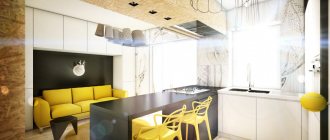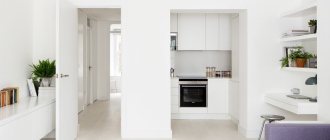Zoning Features
The main purpose of separating the living room and kitchen is to designate separate areas without using solid walls. Thanks to this, the room visually becomes larger, and the interior acquires originality. Here you can not limit your imagination and bring all your design ideas to life.
The kitchen is divided into several parts:
- for cooking;
- dining room;
- bar;
- place to relax.
Even if the kitchen is small, it can be divided into a working part and a dining part.
There are 4 sections in the living room:
- sofa with coffee table;
- TV;
- one or two closets for things;
- shelves for books and souvenirs.
You can also move the dining area into the living room. A table and chairs are sometimes placed in the center of the room. But there are other examples of their placement.
Zoning the kitchen and living room: 65 beautiful ideas (photos)
Have you been thinking about a kitchen-living room for a long time, but don’t know how to organize the space? You will need proper zoning to conveniently place both a cooking surface and a place to relax. But what if you need a full-fledged dining table and workspace? But all this is not a problem if you use partitions and furniture placement correctly. We’ll tell you how to do this now!
What kind of housing is the connection suitable for?
Combining a kitchen and living room is an ideal option for small apartments. Zoning will also be needed when the premises are one whole.
Generally speaking, the connection is suitable for apartments and houses where space feels tight. The interior will also appeal to those who like to be “in touch” with guests.
Zoning in the kitchen
Anyone who has a large kitchen space has long understood that it should not look deserted; proper arrangement is required. Design methods ensure zoning of the kitchen, and if approached correctly, it will connect not only the food preparation area, but also the dining room with the living room.
Advantages and disadvantages
Dividing the room into a kitchen and living room has many advantages:
- It becomes possible to receive many guests at the same time.
- No need to go back and forth setting the table.
- There is no need to purchase a separate TV for the kitchen.
- Both household members and guests can watch the cooking if they wish.
- The woman will have her children in full view.
- Family members will be able to spend more time together.
There are many ways to divide rooms, which allow you to create an interior according to your tastes and preferences. But zoning also has disadvantages:
- with poor ventilation, odors “walk” freely around the apartment;
- you need to clean both the kitchen and living room more often;
- You won’t be able to relax in silence if someone is cooking.
Another disadvantage is the inability to privacy and the complete lack of personal space.
Lighting and decorative elements when zoning
Lighting
In any modern interior, lighting plays a significant role, especially when it comes to zoning the kitchen space. As usual, the work area requires more lighting and without any frills.
Eg:
- fluorescent lighting fixtures above the sink;
- They are also above the cutting table - they allow you to fulfill the practical purpose of these items and comfortably carry out work in the kitchen.
In the recreation area (dining room), light plays a more decorative role: decorative lamps are used to match the style of the interior. You can hang a lowering lamp (lampshade) above the dining table, which will clearly indicate the eating area.
It makes sense to use light to mark the transition between zones by equipping, for example, a hanging cornice with spotlights and leaving them in plain sight (as an option, hide them in a niche made in a wide cornice under the ceiling, while the lamps shine upward).
Artificial lighting - point zoning method
Read also the article about proper kitchen zoning.
Decor elements
The space is zoned quite effectively with the help of decorative elements. A lot here depends on the wild imagination of the apartment owner, so the price of the idea will also depend on him.
There are such types of decor as:
- water curtains;
- ornamental plants in floor pots and on through shelves.
Combination options
You can differentiate between the kitchen and the living room in several ways: using partitions, arches, textiles, furniture and even color.
Bar counter
This zoning technique is considered classic and most popular. It is suitable for any size premises. The structure is installed on the site of the former wall.
This unique partition can be highlighted using lighting.
The bar counter hides some unsightly elements and acts as an island table. You can install shelves and drawers in it, thanks to which you can save useful meters and conveniently place various small items.
If necessary, the bar counter can be replaced with cabinets and tables. Often sinks are installed in them.
Podium
This method of dividing space began to be used relatively recently. It has a number of features. One of them is the possibility of installation only in rooms with sufficient ceiling height and area.
Different zones are placed on the podium. However, more often it is a kitchen set, which is covered on one side by a bar counter. You can also raise the living room or relaxation area. This will allow you to escape from the daily hustle and bustle and relax.
Expert opinion
Olga Kovalenko
Since 2010 I have been engaged in interior design and architectural design.
Designers recommend enhancing the podium steps with lighting or original decorative elements.
Partition
This design performs several functions at once:
- protects the living room from kitchen odors;
- decorates the room;
- is a support.
In old houses, part of the wall can act as a partition. In new ones, it is made of drywall, wood or columns.
For small apartments, designers have developed multifunctional partitions. They play the role of shelves, serve as a stand for a TV or flowers. An aquarium is also installed here.
Important! Zoning with a partition has one important feature. The side of the element that faces the kitchen must be resistant to grease contamination.
Arch
Using this element to separate the kitchen from the living room is possible only when there is a solid wall between them. This method of zoning allows you to preserve it, meet BTI requirements and increase the area of the room.
Arches are suitable for any interior and style, large and small rooms. They either continue the wall or are a separate element. It all depends on the imagination of the designer and the owner of the apartment.
Sliding walls
Zoning the living room, kitchen and dining room using mobile structures appeared not so long ago. Wood, plastic and even textiles are used to make such walls.
Glass products look beautiful. They are decorated with stained glass windows, photo prints, paintings, and ice patterns. Many housewives choose to imitate water droplets.
Glass walls have many advantages, including the ability to transmit light, easy maintenance, durability and safety.
Textile
Fabric partitions are classic curtains mounted on a cornice. This is a good option for small rooms, since soft products do not take up space and are easy to clean.
Special screens with fabric inserts are often used. The most practical option is a double partition. On the kitchen side it is covered with fabric that is resistant to stains.
Color
Using different shades, zoning of the floor in the kitchen and living room, ceiling and walls is performed. Colors can be either close in spectrum or contrasting.
Expert opinion
Olga Kovalenko
Since 2010 I have been engaged in interior design and architectural design.
You can separate rooms not only by color, but also by using materials that differ from each other in texture. The main thing is that they are in harmony with each other.
Furniture
This is the simplest and most affordable method of zoning. Various designs can be used here:
- Pass-through rack. Acts as a partition and display case for dishes and decorative elements. If possible, it is worth purchasing products on wheels. They can be easily moved to the right place at any time.
- Sofa installed “facing” the living room. From the kitchen side, it is recommended to place a small table or cabinet behind its back. The main thing is that it should not be higher.
- A floor cabinet on which a bar table top is installed. It is convenient to approach this element from both sides.
You can divide the room into zones with racks of indoor flowers. An alternative to them are hanging baskets.
Zoning methods
The most difficult part of zoning the kitchen and living room is to delimit the two spaces so that they do not interfere with each other. In this case, you need to take into account the specifics of the kitchen work area when choosing materials and finishes. And at the same time it is convenient to place not only the set, but also the entire work triangle with a sink, stove and refrigerator.
Static partitions
If you don’t like continuous combined spaces, full-fledged static partitions will suit you. A lightweight frame or plasterboard structure will replace entire brick or block masonry. Thermal and sound insulation without additional layers of mineral wool will be lower, but you will save space.
In spacious modern living rooms, static glass partitions look interesting. Moreover, the glass is not necessarily transparent: it can be frosted, tinted, or with patterns. Pay attention to designs made from glass block cubes: they are larger, but also more original. Wood, concrete, remains of brick and any other materials are also suitable for partitions.
To zone kitchen-living rooms, low partitions are often used - at the level of the countertop or bar counter. This is how you can use a ready-made structure and do without unnecessary furniture. And if you leave niches at the bottom, they can easily replace several wall shelves or a small rack.
An elegant technique is arches of any size and shape, from classic to wide and barely outlined. Rectangular or rounded arches are an eternal classic, and round, trapezoidal or any other curly arches are good in creative designer interiors. Niches, lighting, decorative cutouts or inserts are just as well built into them.
Screens and movable partitions
If there is not enough space in your kitchen-living room or you simply do not want to clutter up the space unnecessarily, use mobile partitions. They can be placed as needed to separate a work area, a guest area or a desk.
Screens and partitions can be folding, retractable and sliding, completely closed or translucent. These include impressive wooden structures, tempered glass, and airy openwork classic screens.
The simplest option is a durable folding frame and fabric or textile filling. For example, such partitions made of bamboo or dark wood with white thin fabric are popular in Japanese and Mediterranean interiors.
Curly carved models with gilding, patina and forged fittings will harmoniously fit into the classics. In rustic interiors, plywood or chipboard painted in pastel colors with floral patterns or decoupage are in use.
Podium
A good alternative to vertical partitions is multi-level horizontal structures. In particular, these are podiums on which you can place both an area with a sofa and a kitchen corner. They can even replace a sofa with armchairs if you make it higher and add soft decorative pillows.
A low podium will smooth out differences between floor coverings well if you are laying tiles in the kitchen and laminate in the living room. A slight rise will clearly emphasize the demarcation without any partitions. The rounded design looks interesting, but it is more difficult to do in practice.
High podiums have another significant advantage: boxes and drawers for storing things can be built in there. A durable wooden frame is covered with plywood and reinforced, depending on its purpose. On a small high podium you can create an elegant green corner.
Curtains and drapes
Instead of partitions and screens, textiles can be used to separate the kitchen from the living room, but there are nuances here. This option will fit well into Provence or classic style, but is rarely appropriate in minimalism or modern. You will have to carefully select the fabric so that it does not accumulate dust and does not absorb odors from the kitchen.
Curtain dividers are still hung on a curtain rod or string, which can be hidden in a multi-level plasterboard ceiling. If you want to separate the seating area or work desk, you can use thicker fabrics. But near the kitchen area they are much less practical and sometimes unsafe.
An interesting technique for classic and romantic interiors is to enclose a sofa or podium with pillows with a canopy. The main thing is to choose a design that you can easily disassemble regularly for cleaning. And keep in mind that this option is for spacious studios, because it is quite bulky.
Kitchen-living room decor rules
When decorating the interior of combined premises, you need to take into account a number of simple requirements:
- It is important to create an overall design. Smooth and even surfaces are suitable for high-tech. In country style, it is better not to use modern household appliances. In the classics, bright plastic products are not used.
- Not only the style should be combined, but also the color design. In the overall design, it is recommended to combine a maximum of 3 shades. With the same color scheme, the smaller area should look darker.
- In the kitchen and living room, the lighting should be bright, and in their borders, weak.
- Small rooms will become visually larger if they are painted in soft pastel colors. This is especially true for work areas.
- Curtains, as well as other elements, must be combined in style and texture. Roman blinds or blinds are suitable for the kitchen.
Often, after zoning, a long narrow room remains. It is not recommended to place furniture along the walls.
Zoning with colors and materials
Colors and textures are one of the most powerful and versatile tools for zoning space. On the floor in the kitchen-living room it is laminate and tiles, on the walls - companion wallpaper, paint, textured plaster or even pure brick. On the ceiling there are multi-level plasterboard or tension structures, in which communications and lighting can be easily hidden.
Color accents can change a room beyond recognition. You can decorate the two main zones in complete contrast or leave one bright wall to visually expand the space. A monochrome interior with colored unifying accessories looks interesting. For example, when decorative pillows on the sofa in the living room echo the potholders and towels in the kitchen.
Dark vertical lines visually lift the ceilings, while horizontal lines push the walls apart. If you don’t like accents, but want to emphasize the difference, play with the game of textures. For example, combine smooth painted walls with decorative plaster, glass wallpaper or brickwork.
The mosaic apron above the worktop combines interestingly with decorative panels with similar motifs. Furniture in the same style visually unifies the space. A catchy and bright sofa or refrigerator will become an independent accessory in the kitchen-living room.
Design tips
To achieve functionality and at the same time make zoning beautiful and stylish, you should listen to the recommendations from experts:
- Do not create narrow corridors.
- Use small details that combine the style of the two rooms. Accessories and decorative elements will add individuality to each zone. Even identical, but differently positioned objects can beneficially divide space.
- When choosing furniture, it is better to give preference to functional models. It should be both comfortable and resistant to stains.
- If possible, you need to eliminate kitchen odors. To do this, it is recommended to install the stove in the farthest corner from the living room or near a large window.
- It is important to think in advance where useful items and kitchen utensils will be stored. In combined premises this issue is most acute. You can solve this by using island tables or bar counters with a closed base.
When choosing a kitchen-living room design, you need to follow consistency. It is desirable that the individual details are consistent with each other and create the impression of a single space.
Ways to divide the kitchen into zones
There are many zoning options, and they depend on many factors.
The following little things play a role here:
- who exactly cooks among the family members;
- what food is customary to eat, etc.
But one point must be taken into account in any case - this is the fact that the transition from the dining area to the working area and back should be unimpeded, and therefore thought out to the smallest detail. Each of the two zones should become a continuation of the picture of the overall interior.
Separation by gender
The simplest and most common division of the kitchen into two zones is done using the floor.
There are no special rules here:
- Coverings can be combined (if the main floor covering is parquet, then the work area can consist of ceramic tiles or porcelain stoneware);
- It is possible to use the same covering (if both kitchen areas use the same material, they can be distinguished using a specific floor covering color or pattern).
Uniform floor pattern in different areas of the room
Kitchen island - type of division into zones
Advice! If you decide to have an island in the kitchen, then you can “slam several birds with one stone”: the communications running from the island will need to be hidden somewhere – the solution could be a low podium installed in the work area.
All communications will be hidden under it, at the same time dividing the working and dining parts of the kitchen into zones. But, of course, it is better to avoid the podium for decorative reasons: it can become unsafe, especially for guests who are not accustomed to such innovations.
In addition, space can be divided into zones using:
- multi-level suspended ceilings;
- through niches;
- hanging cornices;
- arches
But it is best to do this in conjunction with the zoning method we described above, using floor coverings.
Read also the article about island kitchen.
Other kitchen zoning methods
Effective ways to divide space into zones:
- Stationary partitions (lattices or glass block partitions);
- Sliding wide partitions, which, if necessary, can be tightly closed to isolate one area from another;
- Zoning using bar counters (especially as an addition to zoning using floors);
Dividing the kitchen into zones using an openwork grid
- A rather rare, but quite effective method of zoning by turning the kitchen unit around. This means that the back of the furniture will become a space divider. But here it is worth considering the following point: the furniture of the dining area should be combined with the set itself. This method is completely doable with your own hands.
Photo gallery
In order to separate the kitchen from the living room, a wide variety of options are used. It all depends on the size of the room, desired functionality and preferences.
You can fence off the kitchen from the living room in different ways. Special partitions, bar counters, ordinary curtains and pieces of furniture are suitable here. It is important that the rooms repeat each other’s style, are comfortable and functional. Only in this case will it be convenient to relax and do household chores in them.
Basic Zoning Rules
Kitchen zoning is the correct division of space . This applies to both functionality and decorative components. There are a number of principles underlying proper zoning. They do not allow the decoration of the room, the custom-made kitchen and accessories to conflict.
6 main zoning rules:
- Unified room style. It will be quite a difficult task to combine Scandinavian style and modern or oriental motifs with rustic in one room. This task is practically impossible. It is necessary to try to choose a single style of room in which several functional areas can coexist. It is better to integrate household appliances and disguise them with decor, thereby avoiding violation of stylistic expressiveness.
- Separate lighting for each zone. In the area of the kitchen unit, a spot one is suitable, in the living and dining area there can be both general and local. Work areas should be lit more brightly, and the dividing area should be softer.
- In the interior, 3 primary colors are desirable, but their accent colors are acceptable. This rule is true for both large and small kitchens. Color accents can overlap in different functional areas. A smaller area of the room is made darker than the larger part.
- If the room is small, it will be better to keep it in light colors. When choosing massive and large-sized furniture as a divider, it can “eat up” the space.
- 2 zones of one room can be zoned with thread curtains. Here, the window design and this divider curtain should have something in common: color, material, texture or other similar parameters.
- If you have a long and narrow room, it is undesirable to place all the furniture along the walls. For such a kitchen, this is a disastrous technique, since it becomes even more elongated. The best option would be to place furniture across, to visually divide a narrow rectangle into squares.
If you have a small kitchen, dividing into zones becomes a difficult task, but even in this situation there are many successful examples of implementing zoning.










